A Short History of Mills Cavalry Web Equipment
In The Development of the Mills Woven Cartridge Belt 1877 - 1956, Albert Lethern mentions that the first patent issued in his name was No. 3220, dated 8th February 1911. This patent was for a Cavalry Web Equipment. He relates that trials of this equipment were held in 1913 by the Hussars, Dragoons, and Lancers at Aldershot, Tidworth, York, and The Curragh (Ireland). After these trials were successfully concluded, the equipment was recommended for adoption by General Sir John French. The onset of war in 1914, though, prevented this from happening.
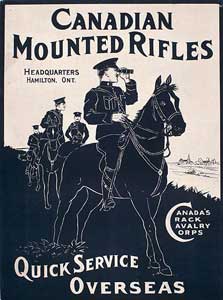 Mr. Lethern's account then jumps forward twenty-five years. He continues, "Curiously enough, in the early days of the second World War certain Cavalry Units were needed with the result that the Cavalry Web Equipment designed in 1911 and brought up to date with improvements such as flat-loop back adjustment belt, hook and loop belt buckle, reduction weave braces, etc., was adopted in 1940 for both men and officers." 1 The new development was, of course, Web Equipment, cavalry, pattern 1940.
Mr. Lethern's account then jumps forward twenty-five years. He continues, "Curiously enough, in the early days of the second World War certain Cavalry Units were needed with the result that the Cavalry Web Equipment designed in 1911 and brought up to date with improvements such as flat-loop back adjustment belt, hook and loop belt buckle, reduction weave braces, etc., was adopted in 1940 for both men and officers." 1 The new development was, of course, Web Equipment, cavalry, pattern 1940.
A few pages earlier, in a discussion on foreign contracts, Mr. Lethern says that, just after the Great War, the Mills Equipment Company had high hopes of developing a business relationship in Spain. He goes on to say "the writer designed ... for the Cavalry an adaptation of his original equipment designed in 1911 (Patent No. 3220) for the British Cavalry." 2
These passages leave the reader with the impression that development of cavalry web equipment ceased after 1914, and that the introduction of the Spanish Cavalry Web Equipment and W.E., cavalry, Patt. '40 were isolated incidents, where Mr. Lethern and the Mills Equipment Company reached back directly to the 1911 design and updated it for specific applications. This article will show that this is not the case. In his all-too-brief history of the Company, Mr. Lethern has left out almost all of this very interesting aspect of M.E. Co.'s design history. In actual fact, Mr. Lethern and M.E. Co. undertook a sustained program of development of Cavalry Web Equipment from 1911 until at least 1925. The evidence to support that proposition far from complete, and it must be said that the historical timeline remains unclear in many areas. However, there is enough material, both documentary and physical, to give a general understanding of the process as it took unfolded.
The fundamental design principles that underlay all of the Mills Cavalry Web Equipment designs are straightforward. The design must accommodate carriage of the necessities a rider requires, these items must be accessible to the rider in the saddle, and the equipment must be comfortable to both the rider and the horse. No matter how they differ in detail, all Mills Cavalry Web Equipment designs meet these requirements in the same fashion. Each design includes Cartridge carriers (or, in the case of officers' equipment, Pistol and Binocular cases, etc.), a Water bottle carrier, and a Haversack for small items. There are the distinctive horizontal straps that extend rearwards from the Cartridge carriers. These support one side of the Haversack and Water bottle carrier across the wearer’s back and above his waist. The other support is by means of Sliding straps, fitted with keyways, that pass over the Braces, held in place by transverse loops. The keyways have “keyhole” shaped slots that mate to special studs on the brace buckles of the Cartridge carriers. When un-fastened from the studs, the Haversack and Water bottle carrier fall back and can then be accessed whilst in the saddle. The foremost transverse loop holds the keyway fitting in an easily accessible position, so that after the item is used, it can readily be returned to its carry location.

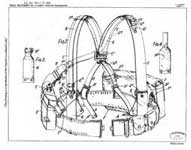 It has to be said that, in many ways, Albert Lethern's original 1911 design lacks finesse. He joined M.E. Co.'s predecessor, the Mills Woven Cartridge Belt Company of London, England, as a junior in 1906, and so had only five years experience under his belt when he designed this equipment. As shown in the drawings accompanying his patent (left and right), this apprentice effort may not be terribly practical as is, but it shows remarkable promise. The 1911 design contains the seeds of all of the major design features that would distinguish every Mills Cavalry Web Equipment to come. These design elements would be reused and refined through successive generations of cavalry webbing designs.
It has to be said that, in many ways, Albert Lethern's original 1911 design lacks finesse. He joined M.E. Co.'s predecessor, the Mills Woven Cartridge Belt Company of London, England, as a junior in 1906, and so had only five years experience under his belt when he designed this equipment. As shown in the drawings accompanying his patent (left and right), this apprentice effort may not be terribly practical as is, but it shows remarkable promise. The 1911 design contains the seeds of all of the major design features that would distinguish every Mills Cavalry Web Equipment to come. These design elements would be reused and refined through successive generations of cavalry webbing designs.
The War Office Trials
The War Office clearly saw value in this design. As mentioned above, the 1911 Cavalry Web Equipment was accepted for extended Troop Trials at a number of locations. To date, I have been unable to locate any original records, or period photographs, of these Trials. Such documentation would have existed, and their discovery would shed light on one of the most interesting and least understood periods of this history. What can be said, with certainty, is that there was continuous development and design refinement throughout the period 1911-1913. This is demonstrated by a pair of surviving examples of the Trials Web Equipments. These incredible survivors, and the Troop Trials themselves, are discussed in the following excerpt, adapted from an un-published article, Web Equipment and the Mounted Soldier, 1899-1965, by R.J. Dennis. Both the article and the photos are © 2008 by R.J. Dennis.3
Established as an English company in 1906, the Mills Equipment Company (M.E.Co.) experienced disappointment with its first full web pattern, Wise-Twigg Equipment. Very quickly, this was developed into their first success, the Mills-Burrowes Equipment, adopted by the British Army as the Pattern 1908 Web Infantry Equipment. The market for an infantry web equipment now sewn-up (woven-up perhaps?!), M.E.Co. turned their attentions to tackling the cavalry, who had continued to use Pattern 1903 Bandolier Equipment. An incredibly complex design was patented in 1911. It is not known if this was ever manufactured, though it is likely Mills would at least have made a working pattern.
The design was based on the 3-inch belt width of Patt. ’08 W.E. and utilised the 2-inch braces of that pattern. In the U.K., M.E.Co. had registered two M.W.C.B.Co. patents, both concerned with methods of adjusting belt length. Neither had any discrete design name, so these have had to be devised! Patent No. 24,228 / 1908 was for what could be described as “flat-sheath belting” and No. 1432 / 1911 for both “opposed flat-loop belting” and “adjacent flat-loop belting”. Whether either of these were actually woven remains to be seen, but M.W.C.B.Co.’s subsequent U.S. web equipment instead employed different methods of adjustment. In the U.K., M.E.Co. took these designs a step further and instead devised “Flat-loop Belting”, a technical term that M.E.Co. coined. The difference being that each loop was now a small pocket, the ends nearest the belt centreline being woven so that they were closed. No specific patent is known for this feature, but it is clearly described in Patent 3220 / 1911, though the change from the U.K. “Twigg Buckle” to a U.S. “Loop & Olivet” is not detailed. The metal fittings are designs from Wise-Twigg Equipment and Mills-Burrowes Equipment, but with several completely new fittings having to be designed. The webbing elements address all the right requirements, but do so in the most incredibly over-engineered way – largely un-necessarily. Note, for instance, that the belting material has “flat-loops” on both the inside and outside faces. It is perhaps significant that it was Albert Alexander Lethern’s very first design. Perhaps he was trying a little too hard to show his mettle, since his occupation in 1906 was as a “Clerk” and he was still a Clerk in 1911, not a “Designer”.
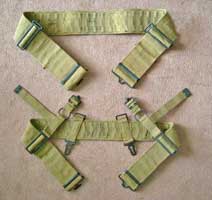 The next two stages are not covered by any known Patents, nor have any photographs been located. It is therefore fortunate that two Waist belts, together with their Brace attachments, have survived in a private collection. These two Waist belts are shown left. From these, it is possible to extrapolate the full designs.
The next two stages are not covered by any known Patents, nor have any photographs been located. It is therefore fortunate that two Waist belts, together with their Brace attachments, have survived in a private collection. These two Waist belts are shown left. From these, it is possible to extrapolate the full designs.
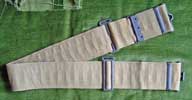 By 1912, the design of 1911 had been greatly simplified into a far more practical form (right). This used a 3-inch wide Belt, waist, in three sizes, Large, Medium and Small. Although of the same width as Pattern 1908 belts, the “Twigg Buckle” had given way to the “Loop and Olivet” form and adjustment was by means of “C” clips carried on metal tips, which engaged the small pockets of the “flat-loop belting” material, these now being on the inside face of the belt only. M.E.Co. had registered Patent No. 18,043 / 1911, ponderously named “Improvements in or relating to Fashioned Woven Fabrics”. In point of fact, it introduced the brilliant concept of “reduction weaving”, whereby strapping could be changed in width along its length, thus reducing the overall weight of webbing. The new Braces were now only 1-inch wide, with 2-inch wide flares over the shoulders, though coupled to a 3-inch belt, it presents an odd appearance. It appears to have been an interim design, as the belt width was reduced in the following year. Another new feature were the Attachments, Brace, Special Design, hugely simplified from the clumsy Patent 3220 form. The belt slides of these date back to at least 1905, as a M.W.C.B.Co. design. M.E.Co. again went the extra yard, coming up with an assembly that would remain largely un-changed through many webbing Patterns, including the major ones of 1919, 1925, 1937, 1944, both Army and R.A.F. Web Equipments for Officers, also being replicated in leather, for the Pattern 1939 Leather Equipment.
By 1912, the design of 1911 had been greatly simplified into a far more practical form (right). This used a 3-inch wide Belt, waist, in three sizes, Large, Medium and Small. Although of the same width as Pattern 1908 belts, the “Twigg Buckle” had given way to the “Loop and Olivet” form and adjustment was by means of “C” clips carried on metal tips, which engaged the small pockets of the “flat-loop belting” material, these now being on the inside face of the belt only. M.E.Co. had registered Patent No. 18,043 / 1911, ponderously named “Improvements in or relating to Fashioned Woven Fabrics”. In point of fact, it introduced the brilliant concept of “reduction weaving”, whereby strapping could be changed in width along its length, thus reducing the overall weight of webbing. The new Braces were now only 1-inch wide, with 2-inch wide flares over the shoulders, though coupled to a 3-inch belt, it presents an odd appearance. It appears to have been an interim design, as the belt width was reduced in the following year. Another new feature were the Attachments, Brace, Special Design, hugely simplified from the clumsy Patent 3220 form. The belt slides of these date back to at least 1905, as a M.W.C.B.Co. design. M.E.Co. again went the extra yard, coming up with an assembly that would remain largely un-changed through many webbing Patterns, including the major ones of 1919, 1925, 1937, 1944, both Army and R.A.F. Web Equipments for Officers, also being replicated in leather, for the Pattern 1939 Leather Equipment.

 The form of Brace Attachment here was of a 3-bar buckle, carried on a length of doubled 1-inch strapping, that was separated by a metal ring. The basic design was illustrated in full as part of Patent 22,130 /1911 (see patent detail drawing at right). The cavalry form of this, carried a mushroom headed stud, riveted into a small extension formed on the outside of the top bar of the buckle. Working in conjunction with this new buckle, another new metal fitting was devised by M.E.Co., the Keyway. This was a fitting that would also survive in their products, last appearing on Pattern 1958 W.E. It was a key shaped component, with a classic “keyhole” shaped opening. A horizontal strap was stitched into the lower web element of each Attachment, pointing back under the wearer’s arm, so they were marked “L” and “R” for the respective sides.
The form of Brace Attachment here was of a 3-bar buckle, carried on a length of doubled 1-inch strapping, that was separated by a metal ring. The basic design was illustrated in full as part of Patent 22,130 /1911 (see patent detail drawing at right). The cavalry form of this, carried a mushroom headed stud, riveted into a small extension formed on the outside of the top bar of the buckle. Working in conjunction with this new buckle, another new metal fitting was devised by M.E.Co., the Keyway. This was a fitting that would also survive in their products, last appearing on Pattern 1958 W.E. It was a key shaped component, with a classic “keyhole” shaped opening. A horizontal strap was stitched into the lower web element of each Attachment, pointing back under the wearer’s arm, so they were marked “L” and “R” for the respective sides.
The pair of Carriers, Ammunition, 45 rds. were of Pattern 1908 form, each pocket internally divided, by “integral weaving”, into three compartments and arranged as one-over-two and interchangeable, left for right. Each end carried a “C” clip that fitted around the beaded edges of the belt, the ends engaging in the two rows of small pockets created by the “flat-loop belting”. The upper cartridge pocket carried a narrow horizontal webbing strip, forming a loop. When assembled onto the belt, this loop was located over the metal ring in the Brace Attachment. After passing through the Brace Attachment buckle, the Brace was passed back through the ring, around the webbing loop and back through the ring. This prevented the top cartridge pocket from falling forward. The Brace end was passed down between the Cartridge Carrier and the Belt.
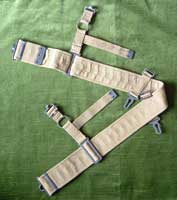 At the rear of the belt, angled chapes in thin webbing were stitched to the inside of the belt. At the top, the chape carried a 3-bar buckle, whilst a Keyway was held at the other end. The Braces had two transverse loops, stitched across the rear parts of the 2-inch flared sections. These loops served to hold in place a 1-inch wide Strap, Sliding each fitted with a Keyway, which engaged the mushroom studs on the Brace Attachment buckles. Completing the set were a Carrier, Water-bottle and a Haversack, each fitted with a mushroom stud on their horizontal undersides. The Bottle carrier was of sleeve form, with angled chapes carrying 1- inch buckles, the Haversack being similarly fitted. The Bottle, water, enamelled. (Mark VI.) was retained by a vee strap of ¾-inch webbing over the bottle shoulders, secured to a press fastener on the front of the sleeve. Judged on the form of the Model 1919 Cavalry pattern, the Haversack flap was secured by only one strap. By a similar token, the dimensions and volume of the Haversack appear to be those of the Patt. ’08 W.E. type, which envelope also formed the basis of the Haversack, Other Services. The horizontal Brace attachment straps and the running ends of the Sliding straps provided four attachment points for the Bottle carrier and Haversack, the base studs of each being engaged on the rear keyways. Thus all the components of the Pattern were firmly held in place, despite the mounted rider’s movements. Disengaging studs from both keyways, allowed both the Water-bottle carrier and the Haversack to be let down and brought to the side of the wearer, allowing for easy access.
At the rear of the belt, angled chapes in thin webbing were stitched to the inside of the belt. At the top, the chape carried a 3-bar buckle, whilst a Keyway was held at the other end. The Braces had two transverse loops, stitched across the rear parts of the 2-inch flared sections. These loops served to hold in place a 1-inch wide Strap, Sliding each fitted with a Keyway, which engaged the mushroom studs on the Brace Attachment buckles. Completing the set were a Carrier, Water-bottle and a Haversack, each fitted with a mushroom stud on their horizontal undersides. The Bottle carrier was of sleeve form, with angled chapes carrying 1- inch buckles, the Haversack being similarly fitted. The Bottle, water, enamelled. (Mark VI.) was retained by a vee strap of ¾-inch webbing over the bottle shoulders, secured to a press fastener on the front of the sleeve. Judged on the form of the Model 1919 Cavalry pattern, the Haversack flap was secured by only one strap. By a similar token, the dimensions and volume of the Haversack appear to be those of the Patt. ’08 W.E. type, which envelope also formed the basis of the Haversack, Other Services. The horizontal Brace attachment straps and the running ends of the Sliding straps provided four attachment points for the Bottle carrier and Haversack, the base studs of each being engaged on the rear keyways. Thus all the components of the Pattern were firmly held in place, despite the mounted rider’s movements. Disengaging studs from both keyways, allowed both the Water-bottle carrier and the Haversack to be let down and brought to the side of the wearer, allowing for easy access.
M.E.Co. used descriptive titles for their products, so a “Pattern Year” did not appear on experimental whole designs, only on those accepted for use in the Services. The term “Model 1912” has therefore been ascribed to the first design, simply for ease of identification. Unlike Pattern 1908 W.E., all metal fittings were of bronzed finish, in the U.S. manner.
In short order, the “Model 1913” form was produced, the Waist belt having been lightened, by a reduction in width to the 2.25-inches. This become the standard width of all web belts produced thereafter and which remains the standard width today, long after the demise of the design company. This was the only change, so the Model 1912 description above will serve for Model 1913.
Trials were underway, but the outbreak of war, in 1914 killed off any hopes of adoption by British Army. The cavalry was still equipped with Patt. ’03 Bandolier Equipment and since large quantities were going to be needed, the War Office stuck with the tried and tested. Evidently, sufficient sets of the trials patterns had been manufactured to give Quartermasters a headache, should they have turned up in stores! The components were therefore listed, in a post-war Priced Vocabulary, as Web Equipment, Cavalry, Experimental. It is presumed that this was the Model 1913 version. An additional item, a Belt, special is assumed to be a plain belt, for Walking Out. It is not known if it was truly plain, in the manner of the simple Canadian Pattern 1913 Belt, Walking Out, or was the Model 1913 belt stripped of back buckles and keyways. For the British and Empire Armies, there was no chance after 1918 of adopting any of Mills’ design developments. The Armies were reduced in size and vast quantities of accoutrements existed, which had to be used up first. For British Cavalry, this meant Patt. ’03 Bandolier Equipment soldiered on into the Second World War.
Development of Cavalry Web Equipment continued beyond the 1914 Troop Trials. By 1916, Mills Cavalry Web Equipment had been greatly refined. Some of these refinements, such as the use of Reduced weave braces, first appeared in the Model 1912 and Model 1913 Trials Equipments. In addition, though, the designs were now incorporated the Mills Back Adjustment principal, having two Cartridge carriers joined by a Back adjustment strap. Even more significantly, Cavalry Web Equipment had now been split into two distinct design lines.
The first of these, here called the "Single Sliding Strap" design, took a new approach. In this design, the Water bottle carrier is mounted directly on the Haversack. There is only a single Strap, with keyway fitting, and both items are accessed from the left side. Only the left Cartridge carrier has the horizontal strap. On his right, the rider carries his rifle slung over the shoulder. The second design line, called the "Double Sliding Strap" design, more closely followed Mr. Lethern's 1911 patent. Here the Haversack and the Water bottle carrier are side-by-side,supported by a pair of Straps, with keyway fittings, and from horizontal straps from both Cartridge carriers.
The "Single Sliding Strap" Designs
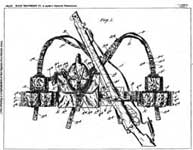
 First documented in Patent No. 108,167, approval dated 23rd July 1917, this version of the Mills Cavalry Web Equipment incorporates a Rifle sling into the design, allowing the soldier to carry a rifle over his shoulder while mounted. The rifle is supported by a pad and loop at the waist (see patent drawing at left), which takes the load off the wearer's shoulder. This design was soon improved with the development of a special Sling that attaches to the left Cartridge carrier and to the end of the left Brace below the right Cartridge carrier, providing additional support and preventing the Sling from exerting any pressure across the chest. This Sling design was also patented, as No. 129,082, acceptance date 30th June 1918 (the drawing to the right came from this patent). British practice at this time was for the mounted trooper to carry his rifle in a rifle bucket on the saddle, rather than slung over his shoulder. This being the case, it is not at first apparent why an alternate approach was required. The rifle shown in the patent drawings is a British SMLE, but the ovoid Water bottle was common in many European armies in the 20th Century. 4
First documented in Patent No. 108,167, approval dated 23rd July 1917, this version of the Mills Cavalry Web Equipment incorporates a Rifle sling into the design, allowing the soldier to carry a rifle over his shoulder while mounted. The rifle is supported by a pad and loop at the waist (see patent drawing at left), which takes the load off the wearer's shoulder. This design was soon improved with the development of a special Sling that attaches to the left Cartridge carrier and to the end of the left Brace below the right Cartridge carrier, providing additional support and preventing the Sling from exerting any pressure across the chest. This Sling design was also patented, as No. 129,082, acceptance date 30th June 1918 (the drawing to the right came from this patent). British practice at this time was for the mounted trooper to carry his rifle in a rifle bucket on the saddle, rather than slung over his shoulder. This being the case, it is not at first apparent why an alternate approach was required. The rifle shown in the patent drawings is a British SMLE, but the ovoid Water bottle was common in many European armies in the 20th Century. 4
 The Single Sliding Strap design reappears in a more solidly British form in a 1919 M.E. Co. catalogue. This catalogue documents four different Mills Web Equipments: an Infantry Equipment, a Cavalry Equipment, a Lewis Gun Equipment, and an Officer's Equipment. The cavalry section offers both Single and Double Sliding Strap designs. Left is a view from this catalogue, showing a British soldier wearing the Single Sliding Strap equipment, this time complete with a British Mk. VI Water bottle. Sadly, of the four designs presented in the catalogue, only the Officer's Equipment was actually produced by M.E. Co., and that only as a private purchase equipment.
The Single Sliding Strap design reappears in a more solidly British form in a 1919 M.E. Co. catalogue. This catalogue documents four different Mills Web Equipments: an Infantry Equipment, a Cavalry Equipment, a Lewis Gun Equipment, and an Officer's Equipment. The cavalry section offers both Single and Double Sliding Strap designs. Left is a view from this catalogue, showing a British soldier wearing the Single Sliding Strap equipment, this time complete with a British Mk. VI Water bottle. Sadly, of the four designs presented in the catalogue, only the Officer's Equipment was actually produced by M.E. Co., and that only as a private purchase equipment.
That doesn't mean that M.E. Co. abandoned the idea of cavalry webbing or the Single Sliding Strap design. Alfred Kruk, in Patronentaschen, Patronengürtel und Banduliere 1850 - 1950, p. 145, shows two drawings of a Single Sliding Strap Cavalry Web Equipment, taken, he says, from a 1925 M.E. Co. catalogue. Interestingly, these drawings show a web equipment using the M.W.C.B. Co. hook and olivet "Mills Military Buckle", instead of the hook and loop buckle Albert Lethern patented in 1919, and which was used in just about every British web equipment from 1919 until the 1970's.
The Single Sliding Strap design was never adopted by the British military. As mentioned above, though, Mr. Lethern designed a cavalry equipment for Spain just after the first World War. The Spanish equipment followed after M.E. Co. entered into an agreement in 1919 with Spanish firm La Industria Lonera S.A. (LILSA). LILSA purchased Mills patent looms and other manufacturing equipment from the Mills Equipment Company and set up a new plant in their Barcelona factory to manufacture web equipment for the Spanish military. Albert Lethern designed new web equipments for both the Spanish infantry and cavalry. The new Spanish Cavalry Web Equipment was almost identical to the Single Sliding Strap equipment illustrated in the 1916 patent drawings, with the addition of the special Rifle sling. The Spanish equipment used the hook and loop belt buckle, and in fact, a close look at the 1916 drawings will reveal what must have been an early prototype for this buckle.
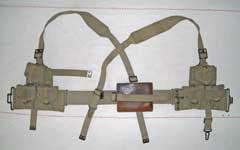 The endeavours required to set up the new Spanish facility were long and involved, and only after protracted efforts did LILSA finally begin to produce some experimental sets of web equipment. By 1924, trials were under way, both in Spain and by the Spanish Foreign Legion in Spanish Morocco. Alfred Kruk, in the work cited above, reproduces two photos of the Infantry Web Equipment in use in Morocco, but no period photographs of the Cavalry Web Equipment have yet surfaced. The political situation in Spain during the 1920's was turbulent, to say the least. LILSA survived as a company, but the production of web equipment seems to have never gotten much past the trials/limited production stage. The partial Cavalry Web Equipment shown here is maker marked "LILSA" and dated 1925. This is the only example of the Spanish Cavalry Web Equipment (and the Single Sliding Strap design) that I have seen. It is incomplete, missing the Haversack, Water bottle carrier, and Strap, with keyway fitting, as well as the accompanying Rifle sling. Detailed photographs of the individual pieces are shown on the "Spanish 1920's Pattern Cavalry Web Equipment - Components" page, which can be accessed below.
The endeavours required to set up the new Spanish facility were long and involved, and only after protracted efforts did LILSA finally begin to produce some experimental sets of web equipment. By 1924, trials were under way, both in Spain and by the Spanish Foreign Legion in Spanish Morocco. Alfred Kruk, in the work cited above, reproduces two photos of the Infantry Web Equipment in use in Morocco, but no period photographs of the Cavalry Web Equipment have yet surfaced. The political situation in Spain during the 1920's was turbulent, to say the least. LILSA survived as a company, but the production of web equipment seems to have never gotten much past the trials/limited production stage. The partial Cavalry Web Equipment shown here is maker marked "LILSA" and dated 1925. This is the only example of the Spanish Cavalry Web Equipment (and the Single Sliding Strap design) that I have seen. It is incomplete, missing the Haversack, Water bottle carrier, and Strap, with keyway fitting, as well as the accompanying Rifle sling. Detailed photographs of the individual pieces are shown on the "Spanish 1920's Pattern Cavalry Web Equipment - Components" page, which can be accessed below.
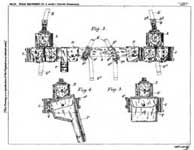 The Spanish 1920's Pattern Cavalry Web Equipment was the only Single Sliding Strap equipment to actually be commercially produced, even on a limited scale. The Single Sliding Strap patent also presented another idea that would surface years later. The drawing at left, again taken from the 1916 patent, illustrates both a combined Pistol case and Cartridge pouch, for the right side of the equipment, and a combined Binocular case and Compass pouch, for the left. The Mills 1917 Web Equipment, Officers, used similar combined cases. In both of these equipments, the combined pairs are mounted on short Side pieces. Each Side piece has a double hook on one end, to engage the flat woven loops on the Back adjustment strap, and one half of the belt buckle on the other. These Side pieces replace the Cartridge carriers on the Back adjustment strap. This concept, and these designs, would eventually be used, almost unchanged, in the Web Equipment, cavalry, Pattern 1940 Officer's equipment.
The Spanish 1920's Pattern Cavalry Web Equipment was the only Single Sliding Strap equipment to actually be commercially produced, even on a limited scale. The Single Sliding Strap patent also presented another idea that would surface years later. The drawing at left, again taken from the 1916 patent, illustrates both a combined Pistol case and Cartridge pouch, for the right side of the equipment, and a combined Binocular case and Compass pouch, for the left. The Mills 1917 Web Equipment, Officers, used similar combined cases. In both of these equipments, the combined pairs are mounted on short Side pieces. Each Side piece has a double hook on one end, to engage the flat woven loops on the Back adjustment strap, and one half of the belt buckle on the other. These Side pieces replace the Cartridge carriers on the Back adjustment strap. This concept, and these designs, would eventually be used, almost unchanged, in the Web Equipment, cavalry, Pattern 1940 Officer's equipment.
The "Double Sliding Strap" Designs
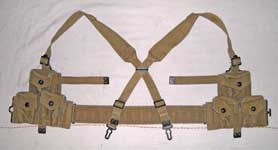 The second 1916 design line, following the 1911 layout, is first seen in several existing partial sets of Cavalry Web Equipment. Alfred Kruk, op. cit., shows one of these (page 144). My own example (left) is typical. It consists of the Cartridge carriers, the Back adjustment strap, and the Braces. Like all of the known partial equipments, each of its component pieces is dated 1916. The Straps with keyway fittings, Water bottle carrier, and Haversack are missing. With one exception, the other known examples are in a similar state of completion. That one, in the collection of Gus Bryngelson, also has the Water bottle carrier. Detailed photographs of the individual components are shown on the "1916 Unknown Cavalry Web Equipment - Components" page, which can be accessed below.
The second 1916 design line, following the 1911 layout, is first seen in several existing partial sets of Cavalry Web Equipment. Alfred Kruk, op. cit., shows one of these (page 144). My own example (left) is typical. It consists of the Cartridge carriers, the Back adjustment strap, and the Braces. Like all of the known partial equipments, each of its component pieces is dated 1916. The Straps with keyway fittings, Water bottle carrier, and Haversack are missing. With one exception, the other known examples are in a similar state of completion. That one, in the collection of Gus Bryngelson, also has the Water bottle carrier. Detailed photographs of the individual components are shown on the "1916 Unknown Cavalry Web Equipment - Components" page, which can be accessed below.
This equipment, although clearly British Mills in design, was manufactured by the U.S. Mills Woven Cartridge Belt Company of Worcester, Massachusetts, (M.W.C.B. Co.) presumably under contract to a European customer. The question of exactly who that customer was is currently a matter of some debate amongst collectors. The problem arises from the fact that, although several sets of the equipment are known, there seems to be neither documentation of this pattern, nor period photographs of it in use. At present, the two leading candidates are Belgium and Portugal. The US Mills Company is known to have produced Infantry Web Equipment for both of these countries. However, it must be noted that in both of those Infantry Equipments, the cartridge pockets have typical "Pattern 1908" style British flap covers. The cartridge pocket covers on this equipment are unusual, being sewn into a "hooded cover" three dimensional shape. The Mills Equipment Company patented this pocket style under Patent No. 115, 094, acceptance date 26th April, 1918, so perhaps this was just an early, "experimental" use of the design.
Most British and American collectors have, until recently at least, accepted the theory that this is a Belgian equipment. When examined critically, though, there is not much evidence to support this idea. The M.W. C. B. Co. did manufacture the Belgian Pattern 1915 Infantry Equipment from a M.E. Co. design. On the components page, a Brace from the Belgian Patt. '15 set is compared with a Brace from this equipment. The colour on the sets I've seen seems to be a lighter shade than the deep brown of Patt. '15, but 90+ years after it was made, colour is a questionable criterion on which to base an opinion. Belgian collectors, at least, are adamant that this equipment is NOT Belgian. Again, though, without hard period evidence this cannot be accepted as fact. 
 On the other hand, the evidence to suggest that it is Portuguese isn't much better. The Royal Army Museum in Brussels exhibits this Web Equipment as part of the Portuguese WWI display, shown in these pictures taken by Gus Bryngelson. The museum has placed this undoubted cavalry webbing on a mannequin wearing an infantry uniform (left), and with a Belgian Patt. '15 Rucksack as part of the same equipment (see detail, right). Given these faux pas, the Royal Army Museum's display can't be considered as definitive. As Gus has commented, in 2001 this mannequin sported the correct Portuguese Infantry Web Equipment, and in these pictures one can see the unfaded areas of the uniform that were once covered by the Braces from that equipment. The Royal Museum has not yet answered his questions on the reason for the change. The Museo Militar in Lisbon, by the way, has been equally reluctant to answer my emailed queries on this Web Equipment.
On the other hand, the evidence to suggest that it is Portuguese isn't much better. The Royal Army Museum in Brussels exhibits this Web Equipment as part of the Portuguese WWI display, shown in these pictures taken by Gus Bryngelson. The museum has placed this undoubted cavalry webbing on a mannequin wearing an infantry uniform (left), and with a Belgian Patt. '15 Rucksack as part of the same equipment (see detail, right). Given these faux pas, the Royal Army Museum's display can't be considered as definitive. As Gus has commented, in 2001 this mannequin sported the correct Portuguese Infantry Web Equipment, and in these pictures one can see the unfaded areas of the uniform that were once covered by the Braces from that equipment. The Royal Museum has not yet answered his questions on the reason for the change. The Museo Militar in Lisbon, by the way, has been equally reluctant to answer my emailed queries on this Web Equipment.
Albert Lethern states that, as early as 1911, M.E. Co. supplied Web Equipment to the Portuguese Army. In the same year, the Mills Company entered into a manufacturing arrangement with the Fabrica de Equipamentos e Arreios in Lisbon, who finished articles of web equipment shipped from the London factory. When the war started in 1914, Mr. Lethern continues, "the British Government allowed the Company to manufacture (mostly from webbings shipped to London from the Worcester, U.S.A., factory) several thousand sets of Equipment for Portugal, Britain's oldest ally. Thereafter, materials were shipped to Lisbon for the Portuguese factory until local developments and the second World War caused a cessation."5 Unfortunately for today's collectors, Mr. Lethern does not mention what type of webbing was supplied. The Mills Portuguese Infantry Web Equipment is well documented in Kruk, pp. 235-236, but he makes no mention of cavalry patterns. It seems that the ultimate user of the 1916 Cavalry Web Equipment must remain, for now at least, a mystery.
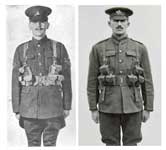
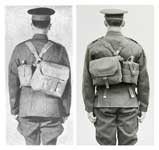 The next piece of evidence in the development of the Double Sliding Strap Cavalry Web Equipment appears in the 1919 Mills Equipment Company catalog mentioned above. In the Cavalry Equipment section, a Double Sliding Strap Web Equipment appears that is so similar to Web Equipment, cavalry, Pattern 1940 that is worthwhile to compare them side-by-side. In each of the two comparison pictures shown here, W.E. Patt. '40 is on the left and the 1919 design is on the right. The Haversack and Water bottle carrier are on opposite sides. In the earlier pattern the "hook and loop" belt buckle is a full 3-inches wide and the Braces have a crossover loop instead of the Brass fitting, but the similarities far outweigh the differences. There can be little doubt that the 1919 design is the direct ancestor of W.E. Patt. '40.
The next piece of evidence in the development of the Double Sliding Strap Cavalry Web Equipment appears in the 1919 Mills Equipment Company catalog mentioned above. In the Cavalry Equipment section, a Double Sliding Strap Web Equipment appears that is so similar to Web Equipment, cavalry, Pattern 1940 that is worthwhile to compare them side-by-side. In each of the two comparison pictures shown here, W.E. Patt. '40 is on the left and the 1919 design is on the right. The Haversack and Water bottle carrier are on opposite sides. In the earlier pattern the "hook and loop" belt buckle is a full 3-inches wide and the Braces have a crossover loop instead of the Brass fitting, but the similarities far outweigh the differences. There can be little doubt that the 1919 design is the direct ancestor of W.E. Patt. '40.
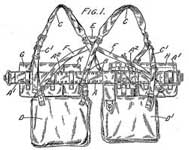
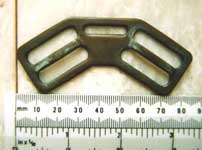
 One final feature found in the Web equipment, cavalry, pattern 1940, is noticeably absent from the most of these early versions of the Cavalry Web Equipment. This is the Fitting, brass, which sat in the centre of the wearer's back and held the Braces in place. Exactly why this elaborate design was required, as opposed to the simple crossover loop previously used, is not clear. It may be that the weight of the Haversack and Water bottle carrier, both hanging from the end of the Straps, with keyway fittings, required the additional support to hold the braces flat against the back. Possibly it just maintained the cross-over point more exactly aligned than a normal web cross-over loop. In more simple terms, it was a piece-part that was already in existence, so Mills used it! The original 1911 Cavalry Equipment patent drawings (see the 1911 Patent section above) showed an early version of this Fitting, then called simply a Slide. The Single and Double Strap equipments which appeared between 1916 and 1925 reverted to the crossover loop alone. The Brass fitting reappeared in 1928, in the Mills Artillery Battery Staff Equipment. The drawing (far left) is taken from Patent No. 311,136, acceptance date 9th May, 1929, for the Battery Staff Equipment. In this patent, the Brass fitting is referred to as a Bridge piece. The piece in the first photo (center left) comes from a partial set of the Battery Staff Equipment, referred to by the Army as Web Equipment, Royal Artillery, or simply W.E., R.A. on display at a museum in England. The second photo, near left, shows a pukkah example of the the Patt. '40 Fitting, brass. The Bridge piece in the Battery Staff Equipment display appears to be identical to the later Fitting, brass.
One final feature found in the Web equipment, cavalry, pattern 1940, is noticeably absent from the most of these early versions of the Cavalry Web Equipment. This is the Fitting, brass, which sat in the centre of the wearer's back and held the Braces in place. Exactly why this elaborate design was required, as opposed to the simple crossover loop previously used, is not clear. It may be that the weight of the Haversack and Water bottle carrier, both hanging from the end of the Straps, with keyway fittings, required the additional support to hold the braces flat against the back. Possibly it just maintained the cross-over point more exactly aligned than a normal web cross-over loop. In more simple terms, it was a piece-part that was already in existence, so Mills used it! The original 1911 Cavalry Equipment patent drawings (see the 1911 Patent section above) showed an early version of this Fitting, then called simply a Slide. The Single and Double Strap equipments which appeared between 1916 and 1925 reverted to the crossover loop alone. The Brass fitting reappeared in 1928, in the Mills Artillery Battery Staff Equipment. The drawing (far left) is taken from Patent No. 311,136, acceptance date 9th May, 1929, for the Battery Staff Equipment. In this patent, the Brass fitting is referred to as a Bridge piece. The piece in the first photo (center left) comes from a partial set of the Battery Staff Equipment, referred to by the Army as Web Equipment, Royal Artillery, or simply W.E., R.A. on display at a museum in England. The second photo, near left, shows a pukkah example of the the Patt. '40 Fitting, brass. The Bridge piece in the Battery Staff Equipment display appears to be identical to the later Fitting, brass.
Whereas no exact purpose was served by this fitting in the basic cavalry sets, it was essential in W.E., R.A. Reference to the extracted Patent drawing at left shows that the pouches at G and H have rear support straps, fixed to brass loops on the rear faces of the pouches. This were attached to the Fitting, brass, providing additional support to the very heavy contents. These pouches held the Daylight Signalling Lamp and its Battery, both contained in their original envelopes / boxes, which fitted directly into these Envelopes.
Web equipment, cavalry, pattern 1940
W.E. Patt. '40 was the last of the Mills Equipment Company's Cavalry Web Equipments, and the only one ever adopted by the British Army. As has been demonstrated here, that equipment was not, as Mr. Lethern's account implies, a unique design resurrected from the past by special circumstances. Instead, W.E. Patt. '40 represented the successful culmination of a design process that lasted for almost thirty years. I can't help but imagine that Mr. Lethern must have felt finally vindicated when the descendent of his first patented design, itself stillborn due to the start of the first World War, was adopted to help fight the second.
Mills Cavalry Web Equipment - Component Pages
These pages provide detailed photos of some of the components of precursors to Web Equipment, Pattern 1940.
War Office Model 1912 and Model 1913 Troop Trials Equipments - Components
1916 Unknown Cavalry Web Equipment - Components
Spanish 1920's Pattern Cavalry Web Equipment - Components
Mills Cavalry Web Equipment - Patents
Listed below are the full texts and drawings of the Mills Equipment Company patents relating directly to Cavalry Web Equipment. The documents are provided as Adobe *.pdf files. Use the back button on your browser to return to this page
The 1908 patent for “flat-sheath belting”.
The 1911 patent for “opposed flat-loop belting” and “adjacent flat-loop belting”.
Patent No. 3220 Improvements in or Relating to Military Equipments, Approval dated 8th February 1912
The original 1911 Lethern patent for the first Mills Cavalry Web Equipment.
The 1911 patent for reduction weaving.
The 1911 patent introducing the form of the Brace attachment.
The 1916 patent for the "Single Strap" Mills Cavalry Web Equipment.
The patent for the "hooded cover" cartridge pocket used on the 1916 "Double Strap" equipment.
Patent No. 129,082 Improvements in or Relating to Military Equipments, Approval dated 30th June 1918
The patent for the special Rifle Sling used with the "Single Strap" equipment.
Patent No. 311,136 Improvements in or Relating to Military Equipments, Approval dated 9th May 1929
The patent for the Battery Staff Equipment.
Footnotes:
1. Lethern, Albert. The Development of the Mills Woven Cartridge Belt 1877 - 1956. London. n.d. [1956], p. 32
2. Lethern, Albert. op. cit., p. 30
3. For additional photos of the Mod. '12 and Mod. '13 Trials Web Equipments, see the War Office Model 1912 and Model 1913 Troop Trials Equipments - Components page.
4. Dennis, R.J., & Bodsworth, J. The Armourer Militaria Magazine, (Issue No. 78 Nov/Dec 2006), “British & Empire Waterbottles 1750-2005”. The design is actually German and aluminium and a suitable nomenclature was devised for it by the authors of this magazine series. This Bottle, water, aluminium (German Pattern) is also known to have been in U.K. service, particularly with officers’ Sam Browne Equipment, Volunteer units in the Boer War 1899-1902 and by some Territorial Force units thereafter. Examples marked to British units have been noted. Part 6, Fig. 15 illustrates such a bottle in a German catalogue of 1911, printed in five languages, including English. Part 2, Fig. 10 (Issue No. 74 Mar/Apr 2006) illustrates an example rigged for carriage on a Sam Browne belt. It is tempting to infer that M.E. Co. may have been looking at a foreign client, very possibly Spain, who did select this webbing pattern. However, the Spanish Foreign Legion had adopted Pattern 1919 W.E., the design adopted by the U.K.’s Royal Navy. Both these countries used British Bottles, water, enamelled. (Mark VI.). It may be that, for cavalry, weight was a consideration, dictating the choice of the aluminium German Pattern, rather than the heavier enamelled British design.
5. Lethern, Albert. op. cit., p. 29